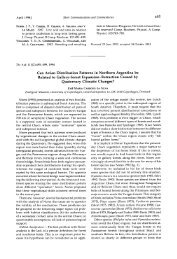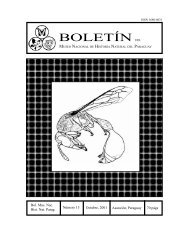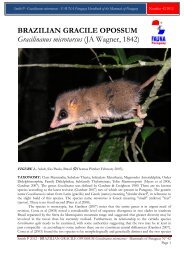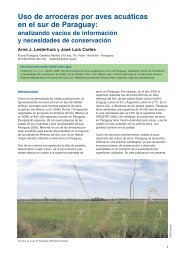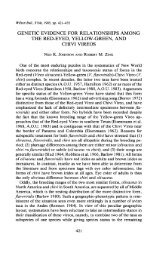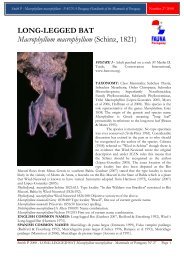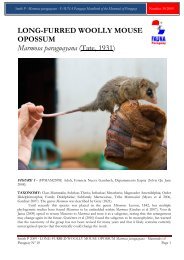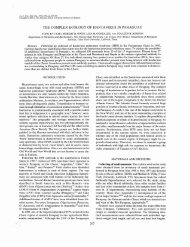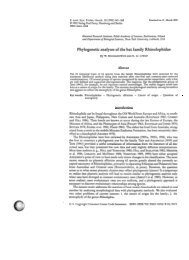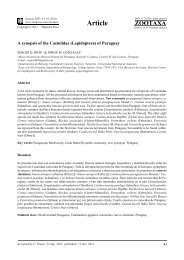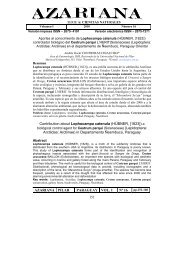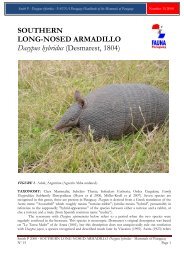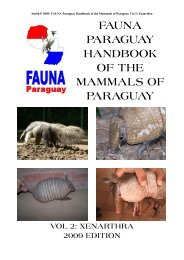Smith P 2007 - FAUNA Paraguay Handbook of the
Smith P 2007 - FAUNA Paraguay Handbook of the
Smith P 2007 - FAUNA Paraguay Handbook of the
Create successful ePaper yourself
Turn your PDF publications into a flip-book with our unique Google optimized e-Paper software.
<strong>Smith</strong> P - Euphractus sexcinctus - <strong>FAUNA</strong> <strong>Paraguay</strong> <strong>Handbook</strong> <strong>of</strong> <strong>the</strong> Mammals <strong>of</strong> <strong>Paraguay</strong> Number 5 <strong>2007</strong><br />
Dasypus flavipes G.Fischer 1814:122. Type locality “Paráguay”.<br />
Dasypus gilvipes Illiger 1815:108. Nomen nudum.<br />
Das[ypus]. gilvipes Lichtenstein 1818:215. Renaming <strong>of</strong> Dasypus gilvipes Illiger (1815).<br />
T[atus]. gilvipes Olfers 1818:220. Type locality “<strong>Paraguay</strong>, Brasilien, Guiana”<br />
Dasypus pilosus Olfers 1818:220. Nomen nudum.<br />
Dasypus encoubert Desmarest 1822:370. Type locality “Le <strong>Paraguay</strong>”.<br />
Tatus sexcinctus Schinz 1824:pl.113. Name combination.<br />
D[asypus]. setosus Wied-Neuwied 1826:520. Type locality “in den Grossen Campos Geraes und den Angrän<br />
zenden Gegenden des Sertong” restricted to Bahía, Brazil by Ávila-Pires (1965).<br />
Euphractus musetlinus Fitzinger 1871:259. In part. Type locality “Sud-und-Mittel-Amerika”.<br />
Scleropleura bruneti Milne-Edwards 1872:1. Type locality “San Antonio … Ceará”, Brazil based on deformed<br />
specimen.<br />
[Dasypus (Dasypus)] sexcinctus Trouessart 1898:1145. Name combination.<br />
[Scleropleura] Bruneti Trouessart 1898:1141. Name combination.<br />
[Dasypus] poyú Larrañaga 1923:243. Type locality implied as Uruguay. Based on Dasypus sexcinctus Gmelin<br />
(1788) (=Dasypus sexcinctus Linnaeus 1758) and de Azara (1802).<br />
Euphrachtus sexcictus Vizcaino et al 1999: 311. Incorrect spelling.<br />
Euphractes sexcictus Nava et al <strong>2007</strong>: 260. Incorrect spelling.<br />
ENGLISH COMMON NAMES: Six-banded Armadillo (Wilson & Cole 2000, Gardner <strong>2007</strong>), Yellow<br />
Armadillo (Parera 2002), White-bristled Hairy Armadillo (Long 2003), Pig Armadillo (Merritt 2008).<br />
SPANISH COMMON NAMES: Armadillo de seis bandas (Neris et al 2002), Armadillo amarillo<br />
(Emmons 1999), Peludo (Emmons 1999), Gualacate (Parera 2002), Peji (Cuéllar & Noss 2004),<br />
Quirquincho de seis bandas (Anderson 1997), Peji grande (Anderson 1997).<br />
GUARANÍ COMMON NAMES: Tatu poju M (Villalba & Yanosky 2000), Poju AP (Villalba &<br />
Yanosky 2000), Krypurá Ac (Villalba & Yanosky 2000), Kry´y pura Ac (Esquivel 2001), Tatuguasu<br />
(Cuéllar & Noss 2004), Gatodejai Ay (Cuéllar & Noss 2004), Tatú poyú (Parera 2002), Tatú-podyu<br />
(Emmons 1999). "Poju" and its variations which feature in <strong>the</strong> Guaraní names refers to <strong>the</strong> needle-like<br />
claws <strong>of</strong> <strong>the</strong> forefeet.<br />
DESCRIPTION: Predominately yellowish to reddish-brown in armour colour (usually yellowish), darker<br />
and somewhat blackish-brown on skin. The head plate is triangular with a straight posterior margin,<br />
coming to a blunt point just before <strong>the</strong> nose and is distinctly flattened on <strong>the</strong> upper part. It is relatively<br />
narrow, <strong>the</strong> width about 70-80% <strong>of</strong> its length. It extends as a spur behind <strong>the</strong> eye and <strong>the</strong>re may be traces<br />
<strong>of</strong> scales in a semi-circle below <strong>the</strong> eye. Scales <strong>of</strong> <strong>the</strong> head plate are large and arranged in a well-defined<br />
pattern. Ears are medium-length, extending backwards to <strong>the</strong> second or third line <strong>of</strong> <strong>the</strong> scapular plate.<br />
They are well-separated by a distance greater than <strong>the</strong> ear-length across <strong>the</strong> top <strong>of</strong> <strong>the</strong> head. The carapace<br />
consists <strong>of</strong> two fixed plates, <strong>the</strong> scapular and pelvic plates, with 6 to 8 movable bands separating <strong>the</strong>m<br />
(typically 6 and rarely 8). There is a single "nuchal" band between <strong>the</strong> head and scapular <strong>the</strong> plate. A sparse<br />
covering <strong>of</strong> long, stiff yellowish-tan hairs sprout from <strong>the</strong> skin between <strong>the</strong> bands. The tail is cylindrical<br />
and well-armoured with 2 to 4 bands <strong>of</strong> scales at <strong>the</strong> base. Two to four holes in <strong>the</strong> plates above <strong>the</strong> tail<br />
base are glandular openings responsible for <strong>the</strong> animals distinctive odour - this character is found only in<br />
Euphractus and Chaetophractus. The forefoot possesses five toes with robust claws, <strong>the</strong> third <strong>of</strong> which is <strong>the</strong><br />
longest. Females have two pectoral nipples. Body temperature is 34ºC.<br />
SKELETAL CHARACTERISTICS: Broad and relatively long rostrum. Interorbital with a marked<br />
postorbital constriction. Brain case with obvious lateral markings, somewhat squarish and flattened.<br />
Zygomatic arch slender and elongate. Jugal never twice as high as <strong>the</strong> overlying anterior edge <strong>of</strong> <strong>the</strong><br />
squamosal. Tympanic bulla present. External auditory meatus is ossified. Condylonasal Length: 114.5mm<br />
(109-125.5mm); Zygomatic Width: 68.6mm (61.7-75.4mm). (Diaz & Barquez 2002, Redford & Wetzel 1985).<br />
Skull illustration based on Chebez (2001) and <strong>Smith</strong> & Redford (1990).<br />
Vizcaino et al (1999) give <strong>the</strong> following ulnar dimensions (n=14): Ulnar Length 70.3mm (+/-4.3);<br />
Olecranon Length 27.9mm (+/-4.0). The trend towards fossoriality is correlated with relative development<br />
<strong>of</strong> <strong>the</strong> olecranon process, and <strong>the</strong> ratio <strong>of</strong> <strong>the</strong> ulnar length to olecranon length is <strong>the</strong> Index <strong>of</strong> Fossorial<br />
<strong>Smith</strong> P <strong>2007</strong> - SIX-BANDED ARMADILLO Euphractus sexcinctus - Mammals <strong>of</strong> <strong>Paraguay</strong> Nº 5<br />
Page 2



